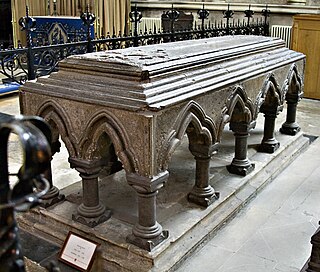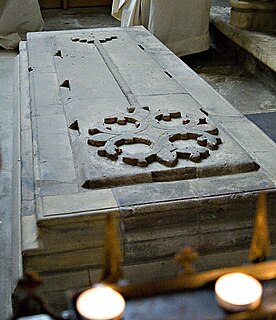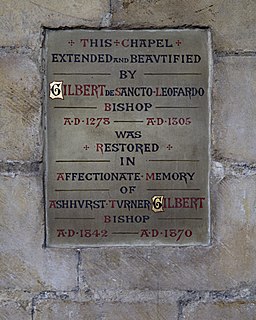Related Research Articles
Robert of Ghent or Robert de Gant was Lord Chancellor of England and Dean of York in the 12th century. The younger son of a nobleman, Robert was probably a member of the cathedral chapter of York before his selection as chancellor by King Stephen of England in the mid-1140s. He is not mentioned often in documents from his time as chancellor, but why this is so is unknown. He became dean at York Minster around 1147. Robert was slightly involved in the disputes over who would be Archbishop of York in the late 1140s and 1150s, but it is likely that his chancellorship prevented his deeper involvement in diocesan affairs. He was no longer chancellor after the death of Stephen, but probably continued to hold the office of dean until his death around 1157 or 1158.
William of York was an English priest and twice Archbishop of York, before and after a rival, Henry Murdac. He was thought to be related to King Stephen of England, who helped to secure his election to the province after several candidates had failed to gain papal confirmation. William faced opposition from the Cistercians, who after the election of the Cistercian Pope Eugene III, had William deposed in favour of a Cistercian, Murdac. From 1147 until 1153, William worked to be restored to York, which he achieved after the deaths of Murdac and Eugene III. He did not hold the province long, dying shortly after his return, allegedly from poison in the chalice he used to celebrate Mass. Miracles were reported at his tomb from 1177. He was canonised in 1226.
John Chishull or John de Chishull was Lord Chancellor of England, Bishop of London, and Lord High Treasurer during the 13th century. He also served as Dean of St Paul's.
Hugh de Puiset was a medieval Bishop of Durham and Chief Justiciar of England under King Richard I. He was the nephew of King Stephen of England and Henry of Blois, who both assisted Hugh's ecclesiastical career. He held the office of treasurer of York for a number of years, which led him into conflict with Henry Murdac, Archbishop of York. In 1153, Hugh was elected bishop of Durham despite the opposition of Murdac.
Henry Murdac was abbot of Fountains Abbey and Archbishop of York in medieval England.

Sewal de Bovil was a medieval Archbishop of York.

Godfrey Ludham was Archbishop of York from 1258 to 1265.
William de Wickwane was Archbishop of York, between the years 1279 and 1285.
Henry of Newark was a medieval Archbishop of York.
Robert of Holy Island was a medieval Bishop of Durham.
Roger Niger was a thirteenth-century cleric who became Bishop of London. He is also known as Saint Roger of Beeleigh.
William Langton was a medieval English priest and nephew of Archbishop Walter de Gray. William was selected but never consecrated as Archbishop of York and Bishop of Carlisle.
Roger of Salisbury was a Bishop of Bath and Wells.
John Climping was a medieval Bishop of Chichester.

Gilbert de St Leonard was a medieval Bishop of Chichester.

William of Louth, also known as William de Luda was a medieval Bishop of Ely.
William Cumin was a bishop of Durham, and Justiciar of Scotland.
Burchard du Puiset was a medieval Anglo-Norman clergyman and treasurer of the diocese of York. Either the nephew or son of Hugh du Puiset, the Bishop of Durham, Burchard held a number of offices in the dioceses of York and Durham before being appointed treasurer by King Richard I of England in 1189. His appointment was opposed by the newly appointed Archbishop Geoffrey, which led to a long dispute between Geoffrey and Burchard that was not resolved until the mid 1190s. After the death of Hugh du Puiset, Burchard was a candidate for the Hugh's old bishopric, but lost out in the end to another candidate. Burchard died in 1196.
Hamo was a 12th- and 13th-century English cleric. He was the Diocese of York's dean, treasurer, and precentor, as well as the archdeacon of the East Riding. His background is unknown, but he was probably a canon of the cathedral chapter at York Minster by 1171. He claimed to have been treasurer of the chapter by 1189, but did not actually hold the office until 1199. Hamo clashed with his archbishop, Geoffrey several times, and when Geoffrey died, Hamo's fellow canons were forbidden by King John of England from electing Hamo to succeed Geoffrey. Hamo died sometime after 1219, when he was last attested as holding his final office, dean.
Hugh Murdac was an English clergyman and canon of York Minster in the 12th and 13th centuries.
References
- Carver, M. O. H. (1980). "Early Medieval Durham: the Archaeological Evidence". Medieval Art and Architecture at Durham Cathedral. British Archaeological Association Conference Transactions for the year 1977. Leeds, UK: British Archaeological Association. pp. 11–19. OCLC 13464190.
- Crouch, David (2000). The Reign of King Stephen: 1135–1154. New York: Longman. ISBN 0-582-22657-0.
- Fryde, E. B.; Greenway, D. E.; Porter, S.; Roy, I. (1996). Handbook of British Chronology (Third revised ed.). Cambridge, UK: Cambridge University Press. ISBN 0-521-56350-X.
- Greenway, Diana E. (1971). "Durham: Bishops". Fasti Ecclesiae Anglicanae 1066-1300. Vol. 2: Monastic Cathedrals (Northern and Southern Provinces). Institute of Historical Research. Retrieved 25 October 2007.
- Greenway, Diana E. (1999). "Deans of York". Fasti Ecclesiae Anglicanae 1066-1300. Vol. 6: York. Institute of Historical Research. Retrieved 25 October 2007.
- Greenway, Diana E. (1999). "Prebends: Unidentified Prebends". Fasti Ecclesiae Anglicanae 1066-1300. Vol. 6: York. Institute of Historical Research. Retrieved 25 October 2007.
- Offler, H. S.; Summerson, Henry (2004). Ste Barbe [Sancta Barbara], William de. doi:10.1093/ref:odnb/38128.